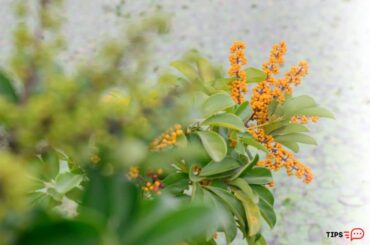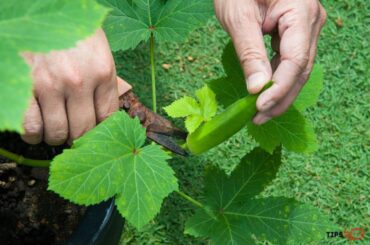We all love to grow plants in residents and other indoor settings as our desire to live and work in a cultivated green space. When the plants are around, we experience calm and relaxation. You may not find a single house that has no plant inside. Indoor plants have gained popularity not only for their natural beauty but also for proven health benefits.
If you are an indoor plant lover and well concerned about proper care of them, especially in terms of fungal disease management, this article on fungicides for indoor plants would be informative for you.

Fungal diseases of indoor plants
When growing indoor plants one of the major issues that we face is fungal infections caused by poor plant health. Fungal pathogens inhabit the soil. If you were unable to care for the plant adequately, the plant will be weakened, leading to activating these fungal pathogens on the plant. A variety of fungal organisms can affect indoor plants, ranging from common problems like anthracnose, fungal leaf spots, powdery mildew, and so.
If you observe indoor plants with unusual spotting, white films, grey moldy patches, brown dead patches, black or discolored patches probably the plant may have a fungal infection problem.
Can you use fungicides for indoor plants?
If you notice a fungal outbreak in your indoor plant, the most effective and guaranteed remedy that you can implement is the use of fungicides. Fungicides act as barriers that prevent the plant from getting infected by fungi. Generally, applying the fungicide before the appearance of symptoms is recommended. But you can apply a fungicide at the first signs of disease to suppress the spreading of the infection and minimize the harm.
Fungicides prevent, destroy, mitigate or inhibit the growth of a wide range of fungal pathogens on plants. These fungicides can be chemical, organic fungicides, or home remedies. Fungicides, especially chemical ones can be used indoors with proper safety measures. Make sure to diagnose the fungal infection that your plant is suffering before applying fungicide.
Plants show distortions even in nutrient deficiencies, pathogenic bacteria, and virus infections. Fungicide has been produced to do a specific function within the plant. So, if you wish to get the maximum benefits of the fungicide, correct identification of the infection is essential.
How do you treat indoor plant fungus?
The best way to control fungal infections is prevention. Make sure you take proper care of your plant. Select healthy disease-free plants or plant materials. Use pasteurized soil. properly fertilize and irrigate the plant. Provide adequate space and good air circulation around the plants.
Fungi can tolerate harsh environmental conditions. They can thrive in moist soil, humid, poorly ventilated areas, and a wide range of temperatures. Keep this fact in your mind when you treat for the fungal infections of indoor plants.
Here we have listed down some practices you can easily implement against indoor plant fungus.
- Examine your indoor plants regularly for the presence of fungus, particularly during fall and winter.
Check whether you see unusual spots vary in color, size, and shape. This will help you to detect the infection early and take necessary action without delay to protect your beloved plant.
- Isolate the infected plants from the rest at the first sign of fungal infection. Remove infected parts of the plant.
This helps prevent other plants from spreading the infection. Keep your plant in a well-ventilated area and treat the plant with a proper fungicide. Once you eliminate the fungal infection from your plant, you can return the plant to its original location.
- If possible, provide bright, indirect light to the infected plant.
Low lighting and poor air circulation lead to fungal infections. Maintain the room temperature preferably above 750F.
- You can treat the infected plant with homemade antifungal solutions or chemical or organic fungicides.
Copper soaps, Sulfur, Chlorothalonil, Tebuconazole, and Myclobutanil are some of the popular fungicides you can use to treat your diseased indoor plants. When you use these fungicides, always follow the instructions given by the manufacturer.
- Be careful about irrigation practices. Avoid over watering the plants.
Water the plant in the morning rather than in the evening. Not like at day times, the drying process of soil is much slower at night due to low temperature. Remember that excess moisture in the soil encourages fungi to pop up.

What causes fungus on indoor plants?
High humidity and poor air circulation around the plants are the foremost causes of fungal infections in indoor plants. Further, low light conditions also make favorable conditions for the growth of pathogenic fungi. Overwatering, poor drainage, poor lighting levels, and planting vegetation without adequate spacing make the indoor plants more open to fungal infections.
What is the best fungicide for plants?
Once you diagnosed the fungal infection correctly the next step is to select the best fungicide to treat the plant. There are a lot of different types of fungicides on the market. We would like to give you a guide to selecting what fungicide you should use.
Natural fungicides
Bacillus amyloliquefaciens Strain D747, Sulfur, and Copper soap are some of the first-line defenses of fungicides that are widely used as less toxic natural fungicides.
Bacillus amyloliquefaciens Strain D747
Here, you can use the Bacillus Strain to treat powdery mildew, fungal leaf spots, and gray mold. The active ingredient of this is a naturally occurring bacterium inhabiting roots, leaves, and other parts of plants. This bacterium prevents colonization of the pathogenic fungi on plant surfaces and at the same time, it acts as a biofertilizer.
Scientific studies have revealed under approved conditions; this fungicide does not present any harmful impacts on human health or the environment. Make sure to follow label directions when you’re applying the fungicide.
Copper fungicides
Copper fungicides are effective to treat fungal leaf spots, downy mildew, powdery mildew, and anthracnose. The active ingredient copper is a natural metal element. It penetrates plant tissue and controls the activities of the pathogenic fungi.
Copper protects plants against developing a new infection. Therefore, you should apply copper fungicide before you see any symptoms of fungal infection. Copper fungicides can withstand frequent wet weather events and are inexpensive. Further, it has a broad spectrum of activity.
Copper is toxic and can damage plant tissues if absorbed in sufficient quantities. Always dilute the product before use. Follow the instructions given on the label of your product to determine the dose and the rate of application. Avoid overapplication. Avoid mixing copper fungicides with surfactants as it can cause more damage to your plant. Copper becomes more soluble in acidic media so do not use copper fungicides with spray acidifiers or other acid-forming products.
Sulfur
Sulfur acts against leaf spots, black spots, and powdery mildew. Sulfur is toxic for fungi and it does not allow fungal spores to germinate. Therefore, it would be effective if you should apply sulfur to plants before the disease develops. You can find sulfur fungicide products in many forms like liquids, wettable powder, and dust.
Application of sulfur at warm temperatures (over 85OF) causes some foliage to burn. Sulfur has a low level of toxicity. If you’re using sulfur powder, take care not to inhale the dust or contact your eyes. Sulfur can cause irritations in the eyes, blurred vision, and skin rashes. Follow the instruction on the label to apply the product safely and protect your plants.
Plant oils
Plant oils, in this sense, neem oil is a well known, safe, non-toxic fungicide. You can use neem oil to treat mildew infections. Some plants can be damaged by neem oil, especially if you apply oil excessively. Therefore, before applying, test a small area on the plant to ensure the oil occurs no damage to the plant. Use oils when the plants are dry. If the plants are wet you will get poor coverage. Avoid mixing oils with sulfur-containing products as it can damage your plant.
Chemical fungicides
Myclobutanil
Myclobutanil, a broad-spectrum fungicide, is used to treat plants infected with anthracnose, fungal leaf spots, and powdery mildew. Myclobutanil suppresses the growth of pathogenic fungi by interrupting membrane function and structure. It interferes with the formation of a vital enzyme called ergosterol which is essential for the cell wall function and thus fungi retards growth and die eventually.
You should apply myclobutanil soon after (or before) infection for maximum benefit. Remember that this fungicide is unable to cure severely diseased plants. Myclobutanil is less toxic and safe to use for indoor plants when applied according to label directions.
Captan
Captan is man-made, one of the general-purpose fungicides used to treat a huge variety of plant diseases but is less effective against powdery mildew. Captan eliminates fungi by interrupting a key process in their life cycle. You can use captan with other fungicides but should not mix with oils, acidic or alkaline materials. This is less toxic but do not contact your eyes. Always follow the instructions given on the label when you’re applying the fungicide.
Chlorothalonil
Chlorothalonil is another general-purpose, broad-spectrum fungicide for many fungal diseases such as fungal leaf spot s, anthracnose, and powdery mildew. Since this persists for a long time you may not want to apply this often. This has less toxicity by the oral and dermal routes but is very toxic by inhalation. Prolonged exposure to chlorothalonil causes skin irritation.

Can we spray fungicides indoors?
You can use fungicide sprays indoors under proper care and safety. You should stick to the instructions given on the label of the product when you’re applying the fungicide. Most fungicides are not labeled as highly toxic or restricted in use. Wear protective clothing when applying fungicides. Make sure to prevent inhalation of fungicides. If pets or children are around, it would be better if you can move the plant to a location where they are unable to reach.
How to make and use homemade fungicide spray?
If you have kids or pets in your home or you are reluctant to use chemical fungicides, here we have described gentler and more natural alternatives to treat your fungal-infected plants. One of the easiest and simplest remedies is to use a mixture of soap and water.
Dissolve one teaspoon of mild liquid soap per liter of water to prepare this antifungal solution. To get optimum results you can add a little amount (about a teaspoon) of baking soda. Completely spray this mixture onto your diseased plants.
Make sure you cover every part of the plant with the mixture. Let the plant dry. Repeat the application as necessary until the recovery of the plant. Prepare a solution dissolving two teaspoons of neem oil and one teaspoon of mild soap in one liter of water. Use mild warm water to facilitate dissolving oil. Spray this solution onto your diseased plants. Continue the treatment as required.
How do you use a fungicide spray on indoor plants?
The most important thing is to adhere to the directions given on the label. Every fungicide may not work on every plant. Select a fungicide compatible with your indoor plant. Usually, for a particular fungicide, applicable plants are listed on its package. Ensure to diagnose the infection before you spray. If you want to use a homemade fungicide, apply it on a small area of the plant and ensure it won’t harm the plant.
When preparing soap containing home mixes, you should never use detergents or soaps with bleaching agents. You should not spray fungicides during flowering times and plants produce edible fruits. If you apply fungicides outdoors, do it during the early morning or evening hours to avoid bright sunlight.
Read Next : How Long Does An Orchid Live Inside?




